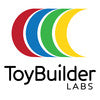As an engineer, one of the greatest pleasures of 3D printing is the ability to prototype ideas fairly quickly -- by choosing low infill and higher layer thickness, ideas for new part can sometimes be explored in less than an hour. While these low-density prints are great for concept verification and fit checks, they don't always hold up well to actual functional use. The low mass has a psychological side-effect of not conveying the true "heft" of a part when the piece will ultimately be machined or injection molded as a solid piece.
To address this, I often like to print "real" parts with infills at 80% to 100%. Those prints are nice because they're much more true to the final parts to be made.
I recently had an occasion to do a test print for a customer that was interested in a more realistic portrayal of metal parts. This was a case where even a 100% infill with plastic did not adequately convey the feel of the final part. By using our highest-density product (GMASS 4.0g/cc filament), I was able to print a part that truly felt like real metal. While I knew (intellectually) that the finished part would be much heavier, it was still a satisfying experience to feel its weight when I first pulled the part off the print bed.
It is important to keep in mind, however, that these simulated parts are placeholders -- simulacrum. While they hold up reasonably well to compression, they are essentially metal powder glued together by the surrounding plastic, so they will fail more readily under tension. Ultimately, you'll need to make and test the part using the final production methods; unless, of course, you plan to go into production with 3D printed parts.
|
0.3 mm layer height |
0.2 mm layer height |
0.2 mm layer height |
Not pictured: Our color-matched HIPS as support material. 4.7 grams.
Overall part size: 43 mm x 74 mm x 26 mm
Parts were sliced with Makerware and printed on MakerBot Replicator 1 Dual.
UPDATE 2015-06-19: For a somewhat cynical spin on the importance of weight, check out this Gizmodo article about Beats headphones...



